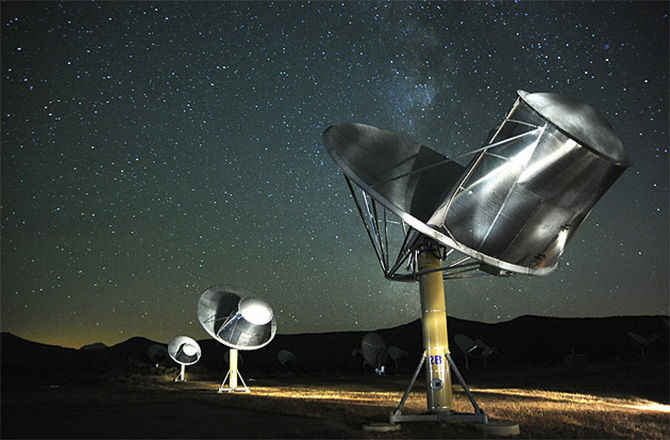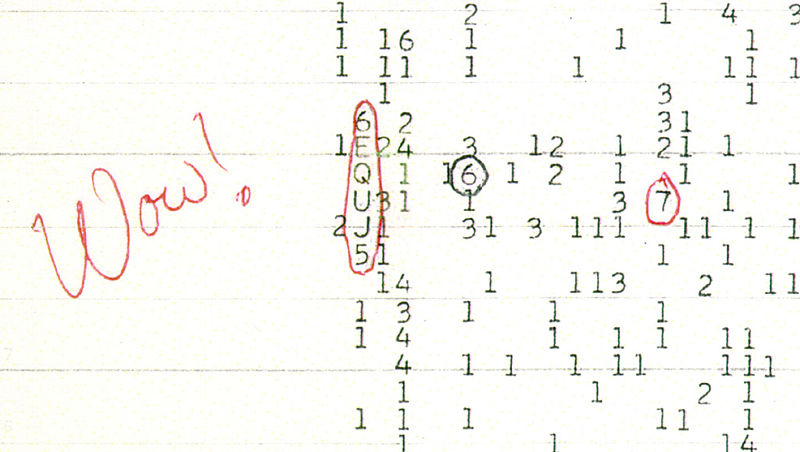Aliens Are Never the Answer

Paul Sutter is an astrophysicist at The Ohio State Universityand the chief scientist at COSI Science Center. Sutter is also host of Ask a Spaceman, RealSpace and COSI Science Now.
You may have heard in the news recently about weird or mysterious radio signals coming from outer space. It doesn't matter when you're reading this article — mysterious radio signals from outer space are almost always in the news. About every six months or so, a flash of excitement and discussion ripples around the world as reports come in from some telescope or probe and the unexplained nature of its observations.
An unusually strong signal from a sun-like star. A repeated pattern that seems too precise to be natural. Bleeps and bloops from unknown sources with head-scratching signatures. Sure, there's a ton of stuff in space that could potentially maybe kind-of-sort-of create those signals, but could this … be it? Could this be the key piece of evidence that answers one of the ultimate existential questions? Are we alone?
No serious astronomer ever wants to rush out and blurt, "Hey, everyone! I've found aliens!" But at the same time, there's a strong desire to get your name in the history books. So when these signals pop up, you get lots of shrugging and hemming and hawing and "Look, we're pretty sure it's natural, but we can't rule out aliens," kind of talk. [Greetings, Earthlings! 8 Ways Aliens Could Contact Us]
Let me tell you a couple of stories.
Pulsars
In the late 1960s, astrophysicist Jocelyn Bell Burnell was working with her adviser, Antony Hewish, with his fancy new radio telescope near Cambridge, England. After scanning a particular spot in the sky, they recorded an unusual signal: A source in the sky was sending frequent, repeated bursts, separated by an eerily precise 1.33 seconds.
The signal was so regular, so exact. Not knowing what to think of it, they cheekily named their source "LGM" — for "little green men." They didn't think they had found an advanced E.T. civilization, but … well, you never know. Better safe than sorry. Just in case.
Sign up for the Live Science daily newsletter now
Get the world’s most fascinating discoveries delivered straight to your inbox.
The LGM hypothesis started to weaken when they found another source, and another, and another. And many others. Finally, the theorists woke up, started paying attention and figured it out: The signals were not caused by little green men, but rather little white neutron stars, wrapped in incredibly strong magnetic fields, beaming jets of radiation into space like a lighthouse. Today, we call them pulsars.
Wow!

In 1977, astronomer Jerry Ehman was listening with his "Big Ear," a radio telescope operated by The Ohio State University. Finished with its scientific mission, the telescope was dedicated to SETI (search for extraterrestrial intelligence) observations. And one night, a huge, bright, continuous signal fell into the telescope's narrow field of view. For 72 seconds, the source shouted into the Big Ear at a peculiar frequency: 1,420 megaherz, the frequency that neutral hydrogen naturally emits via a spin-flip transition of its electron. It was a very unmistakable frequency, a cosmological calling card.
Ehman was so impressed by the signal that he wrote "Wow!" on the printed output of the telescope, but unfortunately, no other telescope saw the signal, and it was never seen again. [Learn more about mysterious radio signals in this video]
Perytons
In 1998, the Parkes radio telescope in Australia started picking up an odd signal: Little "chirps" would occasionally hop from one frequency to another, lasting just a few milliseconds and coming from seemingly nowhere. Chirp, chirp, chirp; the little signals — called "perytons" — befuddled the telescope operators and astronomers across the world for decades.
That is, until 2015, when graduate student Emily Petroff and collaborators nailed the culprit: the microwave in the visitor center. You ever get impatient and open the microwave door before it's done? Yeah, their particular model didn't shut down very quickly and would leak a little bit of microwave radiation that the telescope picked up.
Aliens are never the answer
In all of these cases, and many more, speculation can overrun evidence — not necessarily by the astronomers involved, but almost always in the discussions surrounding the detections. The public is primed for alien transmissions: We talk to each other with radio, and if the SETI Institute or other groups pick up a weird radio signal, maybe it's aliens talking to us, we surmise.
Here's the thing: The hypothesis that aliens are causing a mysterious radio signal is almost always useless, because intelligent creatures can create almost any signal they want. Hear a bleep-bleep-bloop? Maybe aliens did it. Whoops! I meant bloop-bloop-bleep. Well, aliens could have done that, too. There's no predictive power in the "aliens did it" hypothesis. We can't ever disprove it. [Watch: Paul Sutter discusses the alien hypothesis]
When a natural astrophysical explanation is weak or not very convincing, there's often a temptation to wonder if aliens are behind it. After all, we can't rule out aliens! Exactly. We can't ever rule out aliens, because intelligent actors are capable of pretty much anything. We can't rule them out, so it's a scientifically useless position.
It's a very, very, very big leap to go from "We don't know what's causing this signal," to "Maybe aliens are causing this signal."
Astronomers love their radio telescopes because they get useful science done, but there are always all sorts of unexplained phenomena in the universe. That's kind of the reason astronomers remain employed — there's lots of stuff we simply don't understand. Signals, features, observations, the works. It's a big universe out there.
I'm not saying it's aliens, but it's not aliens.
Learn more by listening to the episode "Where do 'weird' radio signals come from?" on the Ask A Spaceman podcast, available on iTunes and on the Web at http://www.askaspaceman.com. Thanks to Kelly M. for the question that led to this piece! Ask your own question on Twitter using #AskASpaceman or by following Paul @PaulMattSutter and facebook.com/PaulMattSutter.
Original article on Live Science.

Paul M. Sutter is a research professor in astrophysics at SUNY Stony Brook University and the Flatiron Institute in New York City. He regularly appears on TV and podcasts, including "Ask a Spaceman." He is the author of two books, "Your Place in the Universe" and "How to Die in Space," and is a regular contributor to Space.com, Live Science, and more. Paul received his PhD in Physics from the University of Illinois at Urbana-Champaign in 2011, and spent three years at the Paris Institute of Astrophysics, followed by a research fellowship in Trieste, Italy.










